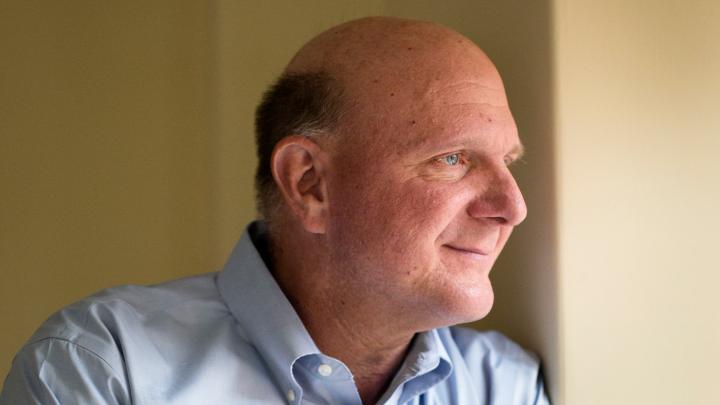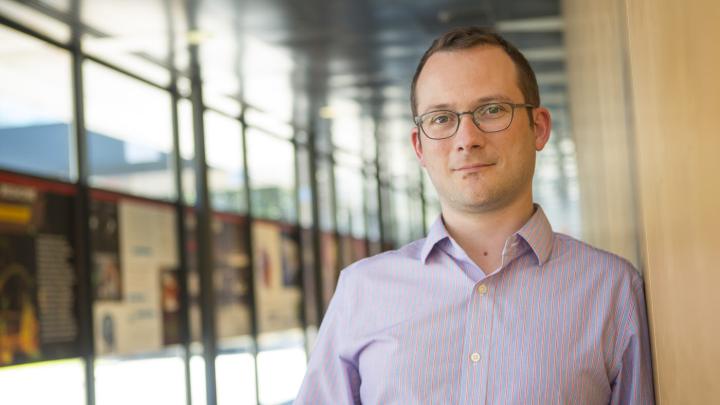Steve Ballmer ’77, then president of Microsoft, and William H. (Bill) Gates III ’77, LL.D. ’07, the company’s co-founder and long-time chief executive, jointly funded Harvard’s Maxwell Dworkin building—the 100,000-square-foot home for computer sciences and electrical engineering (within the School of Engineering and Applied Sciences; SEAS) that bears the names of their mothers, Mary Maxwell Gates and Beatrice Dworkin Ballmer. At the dedication, in October 2000, Ballmer declared, “We want Harvard to have absolutely the greatest computer science and electrical engineering department in the country.” Today, through a momentous gift, Ballmer is effecting a sort of philanthropic hat trick:
- advancing the objective he articulated in 2000;
- going a long way toward fulfilling the objectives of the entire $450-million SEAS capital campaign; and
- pointing the way, more or less, for the computer-sciences faculty to outgrow its relatively new home.
Harvard announced that Ballmer would endow a 50 percent increase in the computer-sciences faculty, which now numbers 24 ladder-track positions (tenured, associate, and assistant professors), plus various lecturers, affiliates, and other teachers.
“The Operating System for Innovation”
In a brief telephone interview on November 12, Ballmer emphasized the importance of strengthening the faculty for “the next era of computing,” in fields such as machine learning and computational theory, which he said were key to propelling “the next wave of innovation and research." Expanding the faculty cohort from 24 to 36 would “enable the Harvard computer-science department really to be built for the future” computing era. He was delighted, he said, to “support the great people” in the department now.
“The field as a whole is at an inflection point,” said David Parkes, Colony professor of computer science and SEAS’s area dean for computer science, who joined Ballmer in the conversation. He sketched the potential for both fundamental advances and the application of computer science to answer large questions in virtually every other field of inquiry. (Parkes himself conducts research and teaches in subjects ranging from artificial intelligence to electronic commerce and computation and economics.)
To that end, he said, an area of particular focus for recruiting new colleagues would encompass artificial intelligence, machine learning, and data science—frontiers that he described as holding the potential to transform how people interact with the world. Evolving techniques will enable scientists to engage with and make sense of enormous sets of data, and will help policymakers understand social problems and devise more effective responses. Harvard’s professional-school breadth strengthens the potential for breakthroughs in medicine, law, and design, among other fields, he said. The department will also seek to grow in fundamental computer-science research, probing the limits of what is possible and what is not; as an analogy, he noted, “A cell is a computer,” processing and sharing information in accord with laws that apply universally.
Ballmer characterized advances in computer science as “the operating system for innovation.” Giving Harvard a bigger footprint, he said, meant pursuing not only the next generation in information technology, but also “the next generation in the study of ancient civilizations and archeology,” and in “economics, medicine, life sciences, the issues of privacy and information security,” and more. In each field, he said, computer science is “the backbone.”
Enlarging Harvard’s faculty better serves both students in the classroom (see below for a discussion of rising enrollments) and research. The expansion “will be fundamental,” Ballmer said, taking Harvard from the ranks of a “very good department” to top-tier status among such institutions as MIT, Stanford, and Carnegie Mellon—all powers in computer sciences. (Among peer institutions, Princeton appears to have 30 ladder faculty members in computer sciences, and has been hiring actively. Stanford lists 54 regular faculty members in computer science, and MIT has dozens in its electrical engineering and computer science unit. Harvard faculty members also cite the University of Washington as a major competitor, as well as other large public institutions.)
Expanding Engineering and Applied Sciences
As reported in October 2013, SEAS’s capital campaign envisions endowing 30 professorships, including 20 new positions, enlarging its faculty ranks from 70 to 90: the largest commitment to faculty growth identified anywhere in the Faculty of Arts and Sciences’ (FAS) $2.5-billion campaign. (SEAS is well on its way, with 82 ladder faculty members at the beginning of this academic year; it is unknown how many are newly funded positions, nor how many current professors are planning retirement, which has been a challenge facing the school even as it tries to grow.)
During the 2013-2014 academic year, according to FAS’s new annual report, the number of SEAS concentrators for the first time exceeded the number of arts and humanities concentrators (in large measure because of growth in computer sciences)—but the ladder-faculty cohort in arts and humanities (196) is more than twice the size of that in engineering and applied sciences. Gordon McKay professor of computer science Harry R. Lewis, director of undergraduate studies, said that as of November 12, the day sophomores were to declare their concentrations, more than a hundred had chosen the field this year, consistent with the experience in 2013-2014. He attributed the appeal of computer sciences among students not only to the external environment—founding the next generation’s Microsoft or Facebook—but also to excitement on campus surrounding innovations in teaching (see below), recent success in attracting new faculty members, and other factors.
SEAS’s planned relocation of much of its faculty to new facilities in Allston, announced in early 2013, is to be underwritten separately, through fundraising conducted as part of the overarching Harvard Campaign objectives (likely supplemented by debt financing). As recently reported, some two-thirds of the school’s faculty members are now slated to relocate, comprising computer science, biomedical engineering, and mechanical engineering; subject to further refinements of the plans for Allston, the electrical engineers will apparently stay put, maintaining some continuity of use in Maxwell Dworkin. They and the other SEAS faculty members remaining in Cambridge (applied mathematicians and physicists, environmental scientists)—who are hard-pressed for laboratory and modern teaching spaces now—will likely grow into the school’s current buildings.
Emphasizing Excellence
In the University news release, Ballmer said of his investment in computer science at his alma mater:
CS at Harvard today is small, but excellent. It already punches above its weight. With depth in systems, data, machine learning, and artificial intelligence, it is focused on high-impact specialties that are literally changing the world. With this infusion of talent, I believe Harvard will be one of the preeminent, modern CS programs.
CS is the operating system for innovation at Harvard. I think Harvard has a unique opportunity. Whether it’s biology, history, public policy, or medicine, the ability to help people get more done through CS is an area where Harvard has the resources and the perspective across these disciplines to be a leader.
To underscore the innovation theme, Ballmer, President Drew Faust, and SEAS dean Cherry Murray (who steps down at year-end) will hold an event at noon at the iLab, Harvard’s workspace for budding entrepreneurs; it will be broadcast at http://www.harvard.edu/live-stream. In the interview on November 12, Ballmer cited the planned development in Allston (where the iLab is located, at the edge of the Harvard Business School campus). Given SEAS’s future facilities there, an emerging entrepreneurial presence nearby, and the longer-term planned development of an “enterprise” campus on Harvard-owned property at Allston Landing, he saw a “phenomenal feedback loop” taking shape, where academic research creates ideas that can be brought to market, and entrepreneurs find the trained talent they need to proceed.
Faust said in the announcement, “The growth in computer science at Harvard will enable our faculty to design their own future. We’re so grateful for Steve’s game-changing support and welcome this opportunity for the School of Engineering and Applied Sciences to take full advantage of the entire University’s distributed gifts.”
Part of Ballmer’s rationale for appearing on campus for events beyond a gift announcement, apparently, is to put his personal imprimatur on emphasizing excellence in engineering and applied sciences at the University, even as the SEAS faculty remains relatively small compared to those at peers such as Princeton and schools such as Caltech—a theme spelled out in his statement in the news announcement.
An Engaged Alumnus
Ballmer has been an actively engaged, loyal alumnus. As an undergraduate, he managed the football team and was [Corrected November 13, 2014, 7:20 p.m. The Crimson has notified the magazine that Steve Ballmer was advertising manager, not business manager, as an undergraduate.] business manager of The Harvard Crimson—ties he has apparently maintained by remaining an avid Harvard sports fan and keeping in touch with recent student staffers at the newspaper. Professor Lewis, a former dean of Harvard College, said of Ballmer, “I love his enthusiasm. It extends from the athletic fields to the computer-science laboratories. He just wants to win, and he really wants Harvard to be the best”—a presence and spirit he called “invigorating” in support of the faculty’s academic ambitions.
Ballmer has backed that spirit up by bearing the University in mind philanthropically, even as he supports other educational institutions as well. (He is teaching at Stanford’s Graduate School of Business, where he was also a student, and his wife, Connie Ballmer, is a trustee of the University of Oregon and chairs its current presidential search. Updated November 13, 2014, 8:00 a.m.: It was a big day for Ballmer family higher-education philanthropy, as they also gave $50 million to the University of Oregon for its $2-billion campaign; the gift underwrites schlarships, health promotion, and an institutional branding initiative.) Ballmer has helped to lead his class’s reunion gift-giving (including the record $68.7-million gift announced during their thirty-fifth campaign), an investment of time and funds.
In keeping with that broad support, Ballmer planned to be on campus for a couple of days this week; among other appointments Wednesday, he was guest lecturer in Computer Science 50, “Introduction to Computer Science,” the wildly popular course taught by McKay professor in the practice of computer science David Malan; one-eighth of Harvard undergraduates are enrolled this term. Interestingly, according to the Yale Daily News, Yale, which has been constrained in hiring computer-sciences professors, has approved introducing CS 50 into its undergraduate curriculum, with broadcast versions of Malan’s lectures and local faculty members and teaching assistants in New Haven, an innovative extension of his course beyond its HarvardX, online version. (Harvard approval of the jointly offered course is pending, the Crimson reports.)
The size of the gift has not been announced. Parkes said “the bulk” of the gift is designated for professorships (as opposed to facilities or research-support funds)—specifically for computer scientists. He said Harvard would hire at both the full-professor and junior-faculty levels as the departments seeks “the very best people,” both in fundamental fields and those who pursue “outward-facing” research that connects to scholars elsewhere at the University, in areas ranging from healthcare to digital humanities. Despite very competitive hiring conditions, he indicated, SEAS had been successful in attracting candidates recently and would be even “more successful going forward.” The department, he understandably said, is “very excited” at the prospect.
(The Harvard Corporation is understood to have set the minimum gift for endowing a new, full professorship in SEAS and recruiting a faculty member to fill it at $6 million—and of endowing an existing professorship at $5 million—during the course of the current capital campaign. That is up from $4 million in the prior decade. Updated November 13, 2014, at 8:00 a.m.: The scale of the gift is therefore likely comparable to Yale alumnus and cable-television pioneer John C. Malone's cumulative benefactions to engineering at his alma mater: $24 million for an engineering building in 2000, followed by a $50-million gift in 2011 to endow 10 new faculty positions.)
Today’s gift is perhaps the biggest Ballmer news since he announced in 2013 that he would step down as Microsoft’s chief executive and his subsequent choice of his “retirement” job: acquiring the National Basketball Association’s Los Angeles Clippers for $2 billion this past summer.








